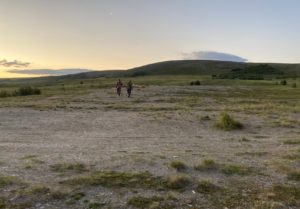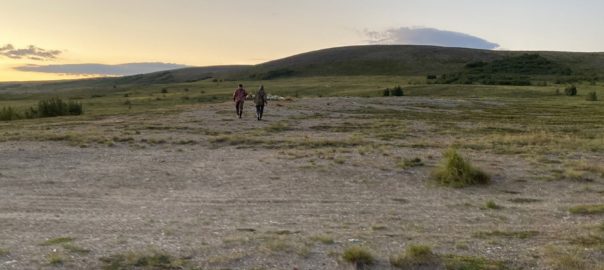The cult of stones and mountains among the Nenets is very well developed and has a significant role in their culture. In the Polar Ural Mountains there are several sacred mountains that are especially revered by the Nenets. The Soviet ethnographer Lyudmila Khomich[1] wrote that it has many similarities with the same cults of mountains among the Sami people.
In general, the veneration of stones and mountains among the Nenets can be associated with the cult of ancestors. In one of the Nenets legends, the stone could appear from a coal of a family hearth[2]. Therefore, some of the Nenets religious objects are represented by stones. Also, this cult of stones and mountains is connected to worshiping of the spirits of the land and its custodians, who can help and protect humans from bad spirits.
In the Nenets culture people worshipped mountains not only as representatives of male and female deities, but usually they are represented as the local land spirits.
There are several sacred mountains in the Polar Ural. The most important mountain is called Pe Mal Khada (grandmother of the edge of the mountains). There are also other sacred mountains: Minesey, Yengania Pe and others.
The Nenets’ legend about the sacred mountain Minesey tells: “Once upon a time, the daughter of Num (a name of the main god of the sky and it means also ‘the sky’), migrated with her caravan in the tundra. Suddenly, she was attacked by the evil spirit Nga. He kidnaped the young woman and turned her reindeer and sledges into the mountains. Thus, the northern part of the Polar Ural Mountains was formed, where the Minesey mountain is one of Num’s daughter’s reindeer”.
In the 1970s, geologists destroyed the singing mountain Yanganya Pe (in Nenets yanganya means ‘special, unusual, uncommon’, pe ‘a stone, a mountain’). They found that it has rich deposits of marble, which were necessary to mine for the needs of the State. Official representatives of the indigenous peoples of Yamal appealed to administrative workers and representatives of the mining company with demands to preserve and protect this sacred place. However, there was nothing they could do in defence of the sanctuary, and documents on the reginal development of this marble deposit mining were already signed in Moscow.
Later, in the 1990s, during the construction of the Ob-Bovanenkovo railway, the stones from the same Nenets sacred mountain Yanganya Pe were used for building Gazprom railway embankments.
Even several years after the destruction of this sacred place, Nenets elders remember the Yanganya Pe mountain as one of the important Nenets sacred places in the Yamal peninsula.

This photo I made during my field trip to Western Siberia in summer 2021. On the photo there is “a branch” of the Nenets sacred place near the Polar Ural. It can be visited by both women and men. The main place is far away in the mountains and according to the religious rules only men are allowed to go there.
In old times the Nenets from different parts of the Yamal tundra came to visit it when it was necessary in difficult life situations. There they prayed and sacrificed to this mountain reindeer. They believe that the Yanganya Pe mountain could sing, because it made unusual whistling sounds which one could hear far beyond the Baydarata river many kilometres far in the tundra until the next sacred mountain Tyorenalova (a shouting place). Probably these sounds were made by the wind in pit caves inside of the Yanganya Pe mountain.
Since the end of the 1990s, the Nenets’ sacred places are recognised to be protected areas, and among them also the Nenets’ sacred mountains. They are recognised as the national treasure of the Yamal-Nenets ethnocultural heritage, historical and archaeology monuments of the Polar Ural mountains[3]. They are also in the list of the state cultural heritage. Since being placed under the state protection, mining work cannot be carried out within the approved boundaries of the territory of the facility’s location.
Endnotes
[1] Khomich, Ludmila. 1977. Religioznye kul’ty u nentsev. Pamiatniki kul’tury narodov Sibiri i Severa. Saint-Petersburg. (Ludmila Khomich describes in Pamiatniki kul’tury narodov Sibiri i Severa” some features of the Nenets cult of stones and mountains).
[2] Laptander, Roza and Piers Vitebsky. 2021. The Covid-19 app and the fire spirit. Receiving messages in Britain and Siberia. Anthropology Today. Volume 37, Issue 6, December 2021. Pp. 17-20. https://doi.org/10.1111/1467-8322.12688
[3] Lar, Leonid. 2003. Cultural monuments of Yamal. Khebidya’ ya. Tumen. See also Kharuchi, Galina. 2013. Sacred places in the traditional and modern culture of the Nenets. Historical illustration. (11 sacred places of Yamal became the objects of cultural heritage of Russia: https://yamal.aif.ru/culture/events/obektami_kulturnogo_naslediya_rossii_stali_11_svyashchennyh_mest_yamala)
